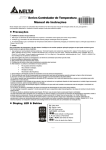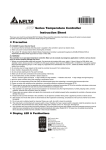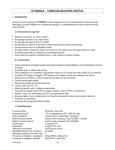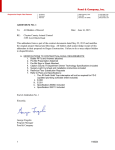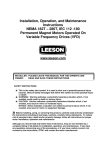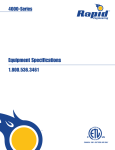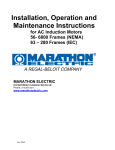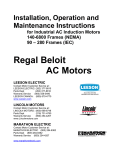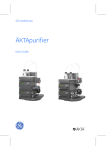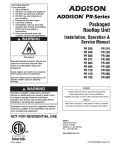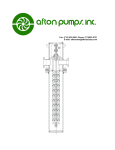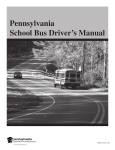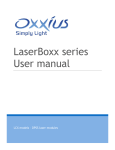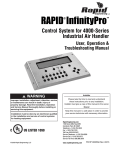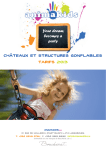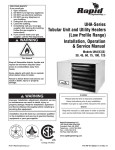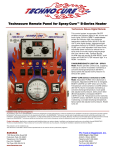Download RP160000NA Rapid E Batch Oven Manual.book
Transcript
WARNING ™ Rapid E-Series Fire Hazard Keep all flammable objects, liquids and vapors the minimum required clearances to combustibles away from equipment. Some objects will catch fire or explode when placed close to equipment. Failure to follow these instructions can result in death, injury or property damage. Standard Electric Batch Ovens Installation, Operation & Service Manual E444 E464 E468 Installer WARNING Improper installation, adjustment, alteration, service or maintenance can result in death, injury or property damage. Read the installation, operation and service manual thoroughly before installing or servicing this equipment. Installation must be done by a registered installer/ contractor qualified in the installation and service of industrial process and finishing equipment. Please take the time to read and understand these instructions prior to any installation. Installer must give a copy of this manual to the owner. Owner Keep this manual in a safe place in order to provide your service technician with necessary information. NOT FOR RESIDENTIAL USE Rapid Engineering LLC 1100 Seven Mile Road NW Comstock Park, MI 49321 Telephone: +1.616.784.0500 Fax: +1.616.784.1910 Toll Free: 800.536.3461 www.rapidengineering.com www.rapidbatchovens.com © 2013 Rapid Engineering LLC P/N RP160000NA Orig. 12/13 TABLE OF CONTENTS SECTION 1: Batch Oven Safety ............................................. 1 1.1 Description of Operation............................................... 1 1.2 Inspection and Setup ................................................... 1 1.3 Safety Labels and Their Placement ............................. 1 1.4 California Proposition 65 .............................................. 1 SECTION 2: Installer Responsibility ..................................... 3 2.1 Corrosive Chemicals.................................................... 3 2.2 Required Equipment .................................................... 4 SECTION 3: Critical Considerations ..................................... 5 3.1 Required Clearances to Combustibles......................... 5 3.2 Hardware ..................................................................... 5 SECTION 4: National Standards and Applicable Codes ..... 6 4.1 National Standards and Applicable Codes .................. 6 4.2 Electrical ...................................................................... 6 SECTION 5: Specifications .................................................... 7 SECTION 6: Lifting a Batch Oven ........................................ 10 6.1 Lifting a Batch Oven................................................... 10 SECTION 7: Batch Oven Installation ................................... 11 SECTION 8: Venting.............................................................. 12 8.1 General Venting Requirements.................................. 12 8.2 Recommended Venting Practices .............................. 12 SECTION 9: Electrical........................................................... 13 9.1 Wiring and Electrical Connections ............................. 13 9.2 Motor Current Draw ................................................... 13 9.3 Control Current Draw ................................................. 13 9.4 Disconnect ................................................................. 13 9.5 Safety Systems .......................................................... 13 9.6 Recirculating Fan Airflow Switch ................................ 13 9.7 Exhaust Fan Airflow Switch........................................ 13 9.8 High Temperature Limit Switch .................................. 13 SECTION 10: Sequence of Operation.................................. 18 10.1 Batch Oven Configuration ........................................ 18 10.2 Control Panel ........................................................... 18 10.3 Temperature Controller ............................................ 18 10.4 Batch Timer.............................................................. 19 10.5 Basic Sequence of Operation .................................. 20 SECTION 11: Start-up Procedures....................................... 21 11.1 Pre Start-Up Checks ................................................. 22 11.2 Electrical ................................................................... 22 11.3 Airflow ....................................................................... 22 11.4 Batch Oven Operation .............................................. 22 11.5 Batch Timer Operation.............................................. 23 SECTION 12: Maintenance ................................................... 24 12.1 General .................................................................... 25 12.2 Unit Exterior ............................................................. 25 12.3 Fans ......................................................................... 26 12.4 Heater Elements ...................................................... 26 12.5 Filters ....................................................................... 26 SECTION 13: Replacement Parts......................................... 27 SECTION 14: Troubleshooting............................................. 28 14.1 Initial Checks............................................................ 29 14.2 General.................................................................... 30 14.3 Temperature Controller ............................................ 31 SECTION 15: The RAPID™ E-Series Warranty .................... 37 © 2013 Rapid Engineering LLC All rights reserved. No part of this work covered by the copyrights herein may be reproduced or copied in any form or by any means - graphic, electronic, or mechanical, including photocopying, recording, taping or information storage and retrieval systems - without the written permission of Rapid Engineering LLC. Printed in U.S.A. TABLE OF FIGURES Figure 1: Label Placement Drawing for Batch Oven ................. 2 Figure 2: Lifting the Batch Oven ............................................. 10 Figure 3: Panel Layout ............................................................ 14 Figure 4: Interconnects Layout................................................ 14 Figure 5: Wiring Diagram ........................................................ 15 Figure 6: Wiring Diagram (continued) ..................................... 16 Figure 7: Wiring Diagram (continued) ..................................... 17 LIST OF TABLES Table 1: Recommended Torque Settings ................................. 5 Table 2: Specifications.............................................................. 8 Table 3: Specifications.............................................................. 9 Table 4: Safety Systems ......................................................... 13 Table 5: Motor Lubrication Intervals........................................ 26 SECTION 1: BATCH OVEN SAFETY SECTION 1: BATCH OVEN SAFETY Your Safety is Important to Us! This symbol is used throughout the manual to notify you of possible fire, electrical or burn hazards. Please pay special attention when reading and following the warnings in these sections. Installation, service and annual inspection of batch ovens must be done by a contractor qualified in the installation and service of industrial process and finishing equipment. Read this manual carefully before installation, operation or service of this equipment. This batch oven is designed for use in non-residential indoor spaces. Do not install in residential spaces. These instructions, the layout drawing, local codes and ordinances and applicable standards that apply to electrical wiring, ventilation, etc. must be thoroughly understood before proceeding with the installation. Protective gear is to be worn during installation, operation and service. Thin sheet metal parts have sharp edges. To prevent injury, the use of work gloves is recommended. 1.1 Description of Operation This batch oven is an electric appliance. It is designed for indoor installation. Batch oven is designed to operate at temperatures as high as 450°F (232°C). Be sure to read this entire manual before installation and start-up. 1.2 Inspection and Setup The batch oven was inspected and operated prior to shipment. Immediately upon receipt of the batch oven, check the electrical characteristics of the batch oven and verify that they match the electrical supply available. Verify that the specifications on the batch oven rating plate match your order. Check the batch oven for any damage that may have occurred during shipment. If any damage is found, file a claim with the transporting agency. Do not refuse shipment. Check the installation location to ensure proper clearances to combustibles. See Page 5, Section 3.1. If the batch oven must be temporarily stored (i.e. job site is not ready for installation of the batch oven), the batch oven should be set indoors to protect it from the environment. 1.3 Safety Labels and Their Placement The equipment must be applied and operated under the general concepts of reasonable use and installed using best building practices. This appliance is not intended for use by persons (including children) with reduced physical, sensory or mental capabilities, or lack of experience and knowledge, unless they have been given supervision or instruction concerning use of the appliance by a person responsible for their safety. Children should be supervised to ensure that they do no play with the appliance. For additional copies of the Installation, Operation and Service Manual, please contact Rapid Engineering LLC. Product safety signs or labels should be replaced by product user when they are no longer legible. Please contact Rapid Engineering LLC to obtain replacement signs or labels. See Page 2, Figure 1. 1.4 California Proposition 65 In accordance with California Proposition 65 requirements, a warning label must be placed in a highly visible location on the outside of the equipment (i.e., near equipment’s serial plate). See label placement drawing on Page 2, Figure 1 for label location. Avoid placing label on areas with extreme heat, cold, corrosive chemicals or other elements. To order additional labels, please contact Rapid Engineering LLC or your RAPID™ independent distributor. This batch oven is not designed for use in atmospheres containing flammable vapors, flammable dust or corrosive chemicals. Recirculated room air may be hazardous if containing flammable solids, liquids, and gases; explosive materials; and/or substances which may become toxic when exposed to heat (i.e. refrigerants, aerosols, etc.). 1 of 35 E-SERIES INSTALLATION, OPERATION AND SERVICE MANUAL FIGURE 1: Label Placement Drawing for Batch Oven Item Part Number 1 19145 2 901010100 3 91070001 4 91070003 5 91070004 6 91070005 7 91070009 8 91070010 9 91070011 10 91070012 11 91070013 12 91070014 13 91070016 14 91070023 15 91070024 16 91070025-ES 17 91070025-FC 18 91070026 3 TOP VIEW Description Label, Logo Label, Installation Manual Inside Label, Shock Hazard (Large) Label, Crush Hazard Label, Fire Hazard (Clearances) Label, Falling Hazard Label, Shock Hazard (Mini) Label, Burn Hazard Label, Fire Hazard (Overheating) Label, Explosion Hazard Label, Severe Injury Hazard Label, Noxious Fumes Hazard Label, Proposition 65 Air Label, Safety Design Label, Rating Label, Operating Instructions (EN/ES) Label, Operating Instructions (EN/FC) Label, Product Damage Hazard SIDE VIEW FRONT VIEW 1 16 17 14 15 9 6 18 5 7 13 APPLIED TO PACKAGING ON OPPOSITE SIDES OF UNIT 4 2 of 35 2 8 10 11 12 SECTION 2: INSTALLER RESPONSIBILITY SECTION 2: INSTALLER RESPONSIBILITY The installer is responsible for the following: • To install the batch oven, as well as the electrical supply, in accordance with applicable specifications and codes. Rapid Engineering LLC recommends the installer contact a local building inspector or Fire Marshal for guidance. • To use the information given in a layout drawing and in the manual together with the cited codes and regulations to perform the installation. • To furnish all needed materials not furnished as standard equipment. • To provide access to batch oven for servicing. • To provide the owner with a copy of this Installation, Operation and Service Manual. • To ensure there is adequate air circulation around the batch oven and to supply air for ventilation and distribution in accordance with local codes. • To assemble or install any accessories or associated vent pipe using best building practices. 2.1 Corrosive Chemicals CAUTION Product Damage Hazard Do not use equipment in area containing corrosive chemicals. Refer to appropriate Material Safety Data Sheets (MSDS). Failure to follow these instructions can result in product damage. Rapid Engineering LLC cannot be responsible for ensuring that all appropriate safety measures are undertaken prior to installation; this is entirely the responsibility of the installer. It is essential that the contractor, the sub-contractor, or the owner identifies the presence of combustible materials or corrosive chemicals anywhere in the premises. 3 of 35 E-SERIES INSTALLATION, OPERATION AND SERVICE MANUAL 2.2 Required Equipment When lifting of the equipment is required, the installing contractor is responsible for supplying or arranging for the appropriate lifting equipment so that the batch oven may be placed in a safe manner. The qualified installing / service technician is responsible for having the appropriate equipment for the safe installation and start-up of a batch oven. Tools required to commission the equipment include, but are not limited to, the following: • Various screwdriver types and sizes • Crescent wrench • Digital multi-meter • Clamp style ammeter 4 of 35 SECTION 3: CRITICAL CONSIDERATIONS SECTION 3: CRITICAL CONSIDERATIONS WARNING Fire Hazard Keep all flammable objects, liquids and vapors the minimum required clearances to combustibles away from equipment. The stated clearances to combustibles represent a surface temperature of 160° F (71.1° C). Building materials with a low heat tolerance (i.e. plastics, vinyl siding, canvas, tri-ply, etc.) may be subject to degradation at lower temperatures. It is the installer’s responsibility to assure that adjacent materials are protected from degradation. Maintain clearances from heat sensitive material, equipment and workstations. 3.2 Hardware Unless specified otherwise, all hardware must be torqued to settings on page. Table 1: Recommended Torque Settings Some objects will catch fire or explode when placed close to equipment. Failure to follow these instructions can result in death, injury or property damage. Bolt Head Grade Marking 3.1 Required Clearances to Combustibles Clearances are the required distances that combustible objects must be away from the batch oven to prevent fire hazards. Combustibles are materials that may catch on fire and include common items such as wood, paper, rubber, fabric, etc. Maintain clearances to combustibles at all times for safety. Check the clearances on the batch oven being installed to make sure the product is suitable for your application and the clearances are maintained. Minimum clearances for all models are as follows: • 36" (91.4 cm) Above the top of the equipment • 36" (91.4 cm) Along the sides of the equipment • 36" (91.4 cm) Around the exhaust piping Read and follow the safety guidelines below: • Locate the batch oven so that the air intakes are not too close to any exhaust fan outlets, gasoline storage, or other contaminants that could potentially cause dangerous situations. • Keep gasolines or other combustible materials including flammable objects, liquids, dust or vapors away from this batch oven or any other appliance. • Maintain clearances from heat sensitive material, equipment and workstations. Clearances to combustibles do not denote clearances for accessibility. Minimum clearance for access is 36" (91.4 cm) in front of control panel per National Electric Code® NFPA 70-latest revision. Nut Grade Marking Bolt Size 10-24 1/4-20 5/16-18 3/8-16 Bolt Head Grade Marking Grade 2 27 in•lb 65 in•lb 11 ft•lb 19 ft•lb Grade 5 42 in•lb 101 in•lb 17 ft•lb 30 ft•lb 8.8 10.9 8.8 10.9 Grade 8.8 6Nm 10Nm 25Nm 50Nm 85Nm 215Nm Grade 10.9 9Nm 15Nm 35Nm 75Nm 130Nm 315Nm Nut Grade Marking Bolt Size M5 M6 M8 M10 M12 M16 5 of 35 E-SERIES INSTALLATION, OPERATION AND SERVICE MANUAL SECTION 4: NATIONAL STANDARDS AND APPLICABLE CODES 4.1 National Standards and Applicable Codes All appliances must be installed in accordance with the latest revision of the applicable standards and national codes. This refers to the electric, ventilation, exhaust and installation. Note: Additional standards for installation in aircraft hangars, etc. may be applicable. 4.2 Electrical Electrical connection to batch oven must be in accordance with the following codes: United States: Refer to National Electrical Code®, NFPA 70 - latest revision. Wiring must conform to the most current National Electrical Code®, local ordinances, and any special diagrams furnished. Canada: Refer to Canadian Electrical Code, CSA C22.1 Part 1 - latest revision. 6 of 35 SECTION 5: SPECIFICATIONS SECTION 5: SPECIFICATIONS A B B ½” Gap Q TOP VIEW D R E D C G L N P S K M G SIDE VIEW G H J T FRONT VIEW NOTE: For dimensioning purposes, Model E468 is composed of two Model E464 ovens mounted end-to-end. Model [in] E444 [cm] [in] E464 [cm] A 28.3 71.8 28.3 71.8 B 27.8 70.6 27.8 70.6 C 4.0 10.2 4.0 10.2 D 23.7 60.2 23.7 60.2 E 8.8 22.2 8.8 22.2 F 0.5 1.3 0.5 1.3 G 4.3 10.8 4.3 10.8 H J K 47.7 56.2 42.6 121.1 142.6 108.1 47.7 56.2 42.6 121.1 142.6 108.1 L 20.5 52.1 20.5 52.1 M N P Q 38.4 60.0 63.3 56.4 97.5 152.4 160.8 143.4 43.8 79.9 84.3 56.4 111.1 203.0 214.2 143.4 R 48.0 121.9 48.0 121.9 S T 24.3 48.1 61.6 122.1 24.3 48.1 61.6 122.1 7 of 35 E-SERIES INSTALLATION, OPERATION AND SERVICE MANUAL Table 2: Specifications Model Inside Dimensions (W x H x D) ft m Physical Data Outside Interior Dimensions Size (W x H x D) ft m ft3 m3 Heat Data Approximate Maximum Heat Shipping Element Temperature Output Weight Qty lb kg °F °C kW E444-15-480-xx 4x4x4 1.2x1.2x1.2 5.3x5.8x5 1.6x1.8x1.5 64 1.8 1,550 703 450 232 15 6 E444-30-480-xx 4x4x4 1.2x1.2x1.2 5.3x5.8x5 1.6x1.8x1.5 64 1.8 1,550 703 450 232 30 12 E444-15-480-xx-E 4x4x4 1.2x1.2x1.2 5.3x5.8x5 1.6x1.8x1.5 64 1.8 1,550 703 450 232 15 6 E444-30-480-xx-E 4x4x4 1.2x1.2x1.2 5.3x5.8x5 1.6x1.8x1.5 64 1.8 1,550 703 450 232 30 12 E444-15-240-xx 4x4x4 1.2x1.2x1.2 5.3x5.8x5 1.6x1.8x1.5 64 1.8 1,550 703 450 232 15 6 E444-30-240-xx 4x4x4 1.2x1.2x1.2 5.3x5.8x5 1.6x1.8x1.5 64 1.8 1,550 703 450 232 30 12 E444-15-240-xx-E 4x4x4 1.2x1.2x1.2 5.3x5.8x5 1.6x1.8x1.5 64 1.8 1,550 703 450 232 15 6 E444-30-240-xx-E 4x4x4 1.2x1.2x1.2 5.3x5.8x5 1.6x1.8x1.5 64 1.8 1,550 703 450 232 30 12 E444-15-220-xx 4x4x4 1.2x1.2x1.2 5.3x5.8x5 1.6x1.8x1.5 64 1.8 1,550 703 450 232 15 6 E444-30-220-xx 4x4x4 1.2x1.2x1.2 5.3x5.8x5 1.6x1.8x1.5 64 1.8 1,550 703 450 232 30 12 E444-15-220-xx-E 4x4x4 1.2x1.2x1.2 5.3x5.8x5 1.6x1.8x1.5 64 1.8 1,550 703 450 232 15 6 E444-30-220-xx-E 4x4x4 1.2x1.2x1.2 5.3x5.8x5 1.6x1.8x1.5 64 1.8 1,550 703 450 232 30 12 E464-15-480-xx 4x6x4 1.2x1.8x1.2 5.3x7.8x5 1.6x2.4x1.5 96 2.7 1,700 771 450 232 15 6 E464-30-480-xx 4x6x4 1.2x1.8x1.2 5.3x7.8x5 1.6x2.4x1.5 96 2.7 1,700 771 450 232 30 12 E464-15-480-xx-E 4x6x4 1.2x1.8x1.2 5.3x7.8x5 1.6x2.4x1.5 96 2.7 1,700 771 450 232 15 6 E464-30-480-xx-E 4x6x4 1.2x1.8x1.2 5.3x7.8x5 1.6x2.4x1.5 96 2.7 1,700 771 450 232 30 12 E464-15-240-xx 4x6x4 1.2x1.8x1.2 5.3x7.8x5 1.6x2.4x1.5 96 2.7 1,700 771 450 232 15 6 E464-30-240-xx 4x6x4 1.2x1.8x1.2 5.3x7.8x5 1.6x2.4x1.5 96 2.7 1,700 771 450 232 30 12 E464-15-240-xx-E 4x6x4 1.2x1.8x1.2 5.3x7.8x5 1.6x2.4x1.5 96 2.7 1,700 771 450 232 15 6 E464-30-240-xx-E 4x6x4 1.2x1.8x1.2 5.3x7.8x5 1.6x2.4x1.5 96 2.7 1,700 771 450 232 30 12 E464-15-220-xx 4x6x4 1.2x1.8x1.2 5.3x7.8x5 1.6x2.4x1.5 96 2.7 1,700 771 450 232 15 6 E464-30-220-xx 4x6x4 1.2x1.8x1.2 5.3x7.8x5 1.6x2.4x1.5 96 2.7 1,700 771 450 232 30 12 E464-15-220-xx-E 4x6x4 1.2x1.8x1.2 5.3x7.8x5 1.6x2.4x1.5 96 2.7 1,700 771 450 232 15 6 E464-30-220-xx-E 4x6x4 1.2x1.8x1.2 5.3x7.8x5 1.6x2.4x1.5 96 2.7 1,700 771 450 232 30 12 E468-30-480-xx 4x6x8 1.2x1.8x2.4 5.3x7.8x9 1.6x2.4x2.7 192 5.4 3,400 1,542 450 232 30 12 E468-60-480-xx 4x6x8 1.2x1.8x2.4 5.3x7.8x9 1.6x2.4x2.7 192 5.4 3,400 1,542 450 232 60 24 E468-30-480-xx-E 4x6x8 1.2x1.8x2.4 5.3x7.8x9 1.6x2.4x2.7 192 5.4 3,400 1,542 450 232 30 12 E468-60-480-xx-E 4x6x8 1.2x1.8x2.4 5.3x7.8x9 1.6x2.4x2.7 192 5.4 3,400 1,542 450 232 60 24 E468-30-240-xx 4x6x8 1.2x1.8x2.4 5.3x7.8x9 1.6x2.4x2.7 192 5.4 3,400 1,542 450 232 30 12 E468-60-240-xx 4x6x8 1.2x1.8x2.4 5.3x7.8x9 1.6x2.4x2.7 192 5.4 3,400 1,542 450 232 60 24 E468-30-240-xx-E 4x6x8 1.2x1.8x2.4 5.3x7.8x9 1.6x2.4x2.7 192 5.4 3,400 1,542 450 232 30 12 E468-60-240-xx-E 4x6x8 1.2x1.8x2.4 5.3x7.8x9 1.6x2.4x2.7 192 5.4 3,400 1,542 450 232 60 24 E468-30-220-xx 4x6x8 1.2x1.8x2.4 5.3x7.8x9 1.6x2.4x2.7 192 5.4 3,400 1,542 450 232 30 12 E468-60-220-xx 4x6x8 1.2x1.8x2.4 5.3x7.8x9 1.6x2.4x2.7 192 5.4 3,400 1,542 450 232 60 24 E468-30-220-xx-E 4x6x8 1.2x1.8x2.4 5.3x7.8x9 1.6x2.4x2.7 192 5.4 3,400 1,542 450 232 30 12 E468-60-220-xx-E 4x6x8 1.2x1.8x2.4 5.3x7.8x9 1.6x2.4x2.7 192 5.4 3,400 1,542 450 232 60 24 8 of 35 SECTION 5: SPECIFICATIONS Table 3: Specifications Model 230 CFM 120 CFM (204 m3/h) (390 m3/h) Recirculation Fan Data Exhaust Exhaust Fan Data Fan Data Airflow Motor Size Motor Size Motor Size Electrical Data Total FLA w/ Total FLA w/ 230 CFM 120 CFM Exhaust Exhaust Fan (A) Fan (A) CFM m3/h HP kW HP kW HP Element V/ø/Hz FLA (A) kW E444-15-480-xx 2,400 4,077 0.5 0.37 N/A N/A N/A N/A 480/3/60 18.0 N/A E444-30-480-xx 2,400 4,077 0.5 0.37 N/A N/A N/A N/A 480/3/60 36.1 N/A N/A E444-15-480-xx-E 2,400 4,077 0.5 0.37 0.03 0.02 0.02 0.01 480/3/60 18.0 21.1 21.4 E444-30-480-xx-E 2,400 4,077 0.5 0.37 0.03 0.02 0.02 0.01 480/3/60 36.1 39.2 39.5 E444-15-240-xx 2,400 4,077 0.5 0.37 N/A N/A N/A N/A 240/3/60 36.1 N/A N/A E444-30-240-xx 2,400 4,077 0.5 0.37 N/A N/A N/A N/A 240/3/60 72.2 N/A N/A E444-15-240-xx-E 2,400 4,077 0.5 0.37 0.03 0.02 0.02 0.01 240/3/60 36.1 42.6 42.9 E444-30-240-xx-E 2,400 4,077 0.5 0.37 0.03 0.02 0.02 0.01 240/3/60 72.2 78.7 79.0 E444-15-220-xx 2,400 4,077 0.5 0.37 N/A N/A N/A N/A 220/1/60 68.2 N/A N/A E444-30-220-xx 2,400 4,077 0.5 0.37 N/A N/A N/A N/A 220/1/60 136.4 N/A N/A E444-15-220-xx-E 2,400 4,077 0.5 0.37 0.03 0.02 0.02 0.01 220/1/60 68.2 76.5 76.8 E444-30-220-xx-E 2,400 4,077 0.5 0.37 0.03 0.02 0.02 0.01 220/1/60 136.4 144.7 145.0 E464-15-480-xx 2,400 4,077 0.5 0.37 N/A N/A N/A N/A 480/3/60 18.0 N/A N/A E464-30-480-xx 2,400 4,077 0.5 0.37 N/A N/A N/A N/A 480/3/60 36.1 N/A N/A E464-15-480-xx-E 2,400 4,077 0.5 0.37 0.03 0.02 0.02 0.01 480/3/60 18.0 21.1 21.4 E464-30-480-xx-E 2,400 4,077 0.5 0.37 0.03 0.02 0.02 0.01 480/3/60 36.1 39.2 39.5 E464-15-240-xx 2,400 4,077 0.5 0.37 N/A N/A N/A N/A 240/3/60 36.1 N/A N/A E464-30-240-xx 2,400 4,077 0.5 0.37 N/A N/A N/A N/A 240/3/60 72.2 N/A N/A E464-15-240-xx-E 2,400 4,077 0.5 0.37 0.03 0.02 0.02 0.01 240/3/60 36.1 42.6 42.9 E464-30-240-xx-E 2,400 4,077 0.5 0.37 0.03 0.02 0.02 0.01 240/3/60 72.2 78.7 79.0 E464-15-220-xx 2,400 4,077 0.5 0.37 N/A N/A N/A N/A 220/1/60 68.2 N/A N/A E464-30-220-xx 2,400 4,077 0.5 0.37 N/A N/A N/A N/A 220/1/60 136.4 N/A N/A E464-15-220-xx-E 2,400 4,077 0.5 0.37 0.03 0.02 0.02 0.01 220/1/60 68.2 76.5 76.8 E464-30-220-xx-E 2,400 4,077 0.5 0.37 0.03 0.02 0.02 0.01 220/1/60 136.4 144.7 145.0 E468-30-480-xx 4,800 8,155 1 0.75 N/A N/A N/A N/A 480/3/60 36.1 N/A N/A E468-60-480-xx 4,800 8,155 1 0.75 N/A N/A N/A N/A 480/3/60 72.2 N/A N/A E468-30-480-xx-E 4,800 8,155 1 0.75 0.03 0.02 0.02 0.01 480/3/60 36.1 40.2 40.5 E468-60-480-xx-E 4,800 8,155 1 0.75 0.03 0.02 0.02 0.01 480/3/60 72.2 78.7 79.0 N/A E468-30-240-xx 4,800 8,155 1 0.75 N/A N/A N/A N/A 240/3/60 72.2 N/A N/A E468-60-240-xx 4,800 8,155 1 0.75 N/A N/A N/A N/A 240/3/60 144.3 N/A N/A E468-30-240-xx-E 4,800 8,155 1 0.75 0.03 0.02 0.02 0.01 240/3/60 72.2 85.5 85.8 E468-60-240-xx-E 4,800 8,155 1 0.75 0.03 0.02 0.02 0.01 240/3/60 144.3 157.6 157.9 E468-30-220-xx 4,800 8,155 1 0.75 N/A N/A N/A N/A 220/1/60 136.4 N/A N/A E468-60-220-xx 4,800 8,155 1 0.75 N/A N/A N/A N/A 220/1/60 272.7 N/A N/A E468-30-220-xx-E 4,800 8,155 1 0.75 0.03 0.02 0.02 0.01 220/1/60 136.4 153.3 153.6 E468-60-220-xx-E 4,800 8,155 1 0.75 0.03 0.02 0.02 0.01 220/1/60 272.7 289.6 289.9 NOTE: FLA ratings may vary depending on supply voltage. Consult factory for more information. 9 of 35 E-SERIES INSTALLATION, OPERATION AND SERVICE MANUAL SECTION 6: LIFTING A BATCH OVEN WARNING Crush Hazard Use proper lifting equipment and practices. Failure to follow these instructions can result in death, injury or property damage. The batch oven must be installed in compliance with all applicable codes. The qualified installation technician must use best building practices when installing the batch oven and any optional equipment. 6.1 Lifting a Batch Oven 6.1.1 Preparing to Lift the Batch Oven: Prior to lifting the batch oven, the following steps must be performed. 1. Remove all packaging or banding that attached the batch oven to the skid and ensure that the batch oven is no longer bound to the skid. 2. Remove all packaging and blockers. 3. Inspect the batch oven to: • Verify that there is no damage as a result of shipping. • Ensure that it is appropriately rated for the utilities available at the installation site. • Verify that the lifting lugs are intact, undamaged and secured to the batch oven. • Ensure factory-installed hardware is torqued as specified. 4. Prepare the installation location to be ready to accept the batch oven. 5. Verify that the lifting equipment can handle the batch oven’s weight and the required reach. 10 of 35 6.1.2 Lifting the Batch Oven Lift the batch oven into place using all four lifting lugs on the batch oven. Use spreader bars to ensure that the lifting cables clear the sides of the batch oven. The batch oven must be kept level during the lift to prevent tipping, twisting or falling. If lifted improperly, product damage may occur. FIGURE 2: Lifting the Batch Oven SECTION 7: BATCH OVEN INSTALLATION SECTION 7: BATCH OVEN INSTALLATION WARNING Crush Hazard Use proper lifting equipment and practices. Failure to follow these instructions can result in death, injury or property damage. WARNING Falling Hazard Use proper safety equipment and practices to avoid falling. Failure to follow these instructions can result in death, injury or property damage. Batch oven is shipped as one piece. No field assembly is required. The batch oven must be floor mounted on a flat level surface that is rated for the oven’s weight. See Page 8, Table 2. In certain municipalities, the batch oven may need to be anchored to the floor to comply with local codes. Rapid Engineering LLC recommends the installer contact a local building inspector for guidance. 11 of 35 E-SERIES INSTALLATION, OPERATION AND SERVICE MANUAL SECTION 8: VENTING WARNING batch oven with an exhaust fan at 0.5 in wc external static pressure (ESP) is 30ft. (9.1m) with no more than two 45° elbows. Total ESP must not exceed 0.5" w.c. Do not install dampers or other restrictive devices in the vent pipe. Noxious Fumes Hazard Properly vent equipment per Installation, Operation and Service Manual. Items placed in equipment could release noxious flumes. Refer to the Safety Data Sheets (SDS) for items placed in equipment. Failure to follow these instructions can result in death, injury or property damage. 8.1 General Venting Requirements Batch ovens equipped with an exhaust fan must be vented in accordance with the rules contained in this manual and with any national, state, provincial or local codes which may apply: United States: Refer to NFPA 91-latest revision, Standard for Exhaust Systems for Air Conveying of Vapors, Gases, Mists and Non-Combustible Particulate Solids. 8.2 Recommended Venting Practices All electric batch ovens are shipped without flue/ vent pipe components. It is the responsibility of the installer to supply the venting components for electric batch ovens shipped with an exhaust fan. Each batch oven must have an individual vent pipe and vent terminal. Termination of the vent pipe must be located so that the vented fumes can not be drawn back into any outside air intakes. Recommended vent pipe for a batch oven equipped with a 230 CFM (390 m3/h) exhaust fan is 5" (12.7cm) diameter pipe of a minimum 22 gauge galvanized steel. Recommended vent pipe for a batch oven equipped with a 120 CFM (204 m3/h) exhaust fan is 4" (10.1cm) diameter pipe of a minimum 22 gauge galvanized steel. The installer must provide a rain cap or weather cap. All joints must be sealed. Do not support the weight of the vent pipe on the exhaust fan's flange. Maximum vent pipe length (horizontal or vertical) of a 12 of 35 The vent pipe should not be installed in such a manner that access to the components is obstructed. The vent pipe shall have a minimum of at least 36" (91.4 cm) clearance to combustibles, and be guarded to protect personnel from coming in contact. Approved listed thimble is to be used wherever the vent pipe passes SECTION 9: ELECTRICAL SECTION 9: ELECTRICAL DANGER Electrical Shock Hazard Disconnect electric before service. More than one disconnect switch may be required to disconnect electric from equipment. Equipment must be properly grounded. Failure to follow these instructions can result in death or electrical shock. Each batch oven is equipped with a wiring diagram. See Page 15, Figure 5 through Page 17, Figure 7. Note: Spark testing or shorting of the control wires by any means will render the transformers inoperative. 9.1 Wiring and Electrical Connections All electrical wiring and connections, including electrical grounding, must comply with; United States: Refer to National Electrical Code®, NFPA 70 - latest revision. Wiring must conform to the most current National Electrical Code®, local ordinances, and any special diagrams furnished. Canada: Refer to Canadian Electrical Code, CSA C22.1 Part 1 - latest revision. Check rating plate on batch oven for supply voltage and current requirements. All heater element wiring and jumpers must be 14 AWG high temperature type “TGGT” braided wire or larger with nickel plated ring terminals. Each electrical element is rated for 2.5 kW at 240 Volts. See Page 14, Figure 3 through Page 14, Figure 4. Two heaters in series at 480 Volts will drop 240 Volts across each element with 18 Amps per phase leg. 14 AWG “TGGT” is rated for 39 Amps at 104° F (40°C). 9.2 Motor Current Draw For current requirements of the motor, see rating plate located on the blower motor. 9.3 Control Current Draw The maximum current draw for a batch oven’s controls and accessories is 4.5 A @ 115 Vac. 9.4 Disconnect Disconnect and suitable branch circuit protection must be provided by others. 9.5 Safety Systems Safety systems are required for proper performance of the batch oven. The batch oven shall not be permitted to operate with any safety system disabled. If a fault is found in any of the safety systems, then the system shall be repaired only by a contractor qualified in the installation and service of industrial process and finishing equipment, using only components that are sold and supplied by Rapid Engineering LLC. See Page 13, Table 4 for a description of each safety device and its switching voltage. Table 4: Safety Systems Safety Controls Recirculating Fan Airflow Switch Exhaust Fan Airflow Switch High Temperature Limit Switch Voltage 120 120 120 9.6 Recirculating Fan Airflow Switch The recirculating fan airflow switch monitors differential pressure across the recirculating fan to ensure the production of proper airflow. When the switch closes (along with the exhaust fan airflow switch, if applicable), it permits the beginning of the heating sequence. This switch is factory set at 0.4 in wc The pressure switch is a safety device, which cannot be field-adjusted or tampered with. 9.7 Exhaust Fan Airflow Switch The exhaust fan airflow switch monitors differential pressure across the exhaust fan to ensure the production of proper airflow. When the switch closes (along with the recirculating fan airflow switch), it permits the beginning of the heating sequence. This switch is factory set at 0.2 in wc The pressure switch is a safety device, which cannot be field-adjusted or tampered with. 9.8 High Temperature Limit Switch If for any reason, the internal temperature of the batch oven exceeds 500° F (260° C), the high temperature limit switch will open the circuit to the batch oven's heating elements and shut them down. 13 of 35 E-SERIES INSTALLATION, OPERATION AND SERVICE MANUAL FIGURE 3: Panel Layout FIGURE 4: Interconnects Layout 14 of 35 SECTION 9: ELECTRICAL FIGURE 5: Wiring Diagram 15 of 35 E-SERIES INSTALLATION, OPERATION AND SERVICE MANUAL FIGURE 6: Wiring Diagram (continued) 16 of 35 SECTION 9: ELECTRICAL FIGURE 7: Wiring Diagram (continued) 17 of 35 E-SERIES INSTALLATION, OPERATION AND SERVICE MANUAL SECTION 10: SEQUENCE OF OPERATION DANGER 10.3 Temperature Controller LOVE CONTROLS SERIES 16C PV °F °C Electrical Shock Hazard SV Disconnect electric before service. More than one disconnect switch may be required to disconnect electric from equipment. AT OUT 1 OUT 2 ALM Equipment must be properly grounded. Failure to follow these instructions can result in death or electrical shock. 10.1 Batch Oven Configuration Based on the application, the batch oven may or may not be configured with an exhaust fan and motor. 10.2 Control Panel The control panel will be factory-mounted to the oven. TEMPERATURE CONTROLER LOVE CONTROLS BATCH TIMER Koyo TIMER SERIES 16C KT-V PV °F °C SV AT OUT 1 OUT 2 ALM FANS ON OVEN PURGING FANS STOP START HEAT ON HEAT RUN STOP START AUTO ALARM SILENCE ALARM HORN The control panel includes an auto/run switch, fans stop/start knob, heat start/stop knob, alarm horn and alarm silence button, three status lights, temperature controller and batch timer. 18 of 35 INDEX ENTER DOWN ARROW UP ARROW The temperature controller interface consists of a message screen and four key function buttons: INDEX: Pressing the INDEX key advances the display to the next menu item. ENTER: Stores the value or item change. If not pressed, the previously stored value or item will be retained. When pressed during the Operation Mode, the controller switches to the Regulation Mode. If held for more than 3 seconds during the Operation Mode, the controller switches to the Initial Setting Mode. If pressed during the Regulation Mode or Initial Setting Mode, the controller will return to the Operation Mode. UP ARROW: Increments a value or changes a menu item. If pressed during the Operation Mode the set point value will be increased. DOWN ARROW: Decrements a vaue or changes a menu item. If pressed during the Operation Mode the set point value will be decreased. 10.3.1 Security Features The controller has two built in security lock settings to prevent unauthorized personel from changing parameter settings. These parameters are set in the Operation Mode. The LoC1 setting affects all parameters in the controller. If LoC1 setting is enabled, the operator will have to unlock the controller to make any changes to the controller’s parameters. SECTION 10: SEQUENCE OF OPERATION The LoC2 setting affects all parameters except the set point. In order to change any other parameters, the operator will have to unlock the control before making a change. 10.4 Batch Timer Output Indicator Set Valve In order to unlock the control, the operator must depress the ENTER and INDEX key simultaneously. 10.3.2 Control Operation Description The HOME display is the normal display with the control is operating. If no errors or functions are active, the HOME display will indicate the Process Variable that is being measured on the top display and the Set Variable on the bottom display. 10.3.3 Operation Menu Upon normal operation, control will be in the Operation Menu. Pressing the INDEX key will cycle through the below menu items. The parameter will be displayed in the bottom display, except for the set point which is displayed in the bottom display on the Home Display. The UP and DOWN arrows change the values of the parameters. The ENTER key must be pressed after any changes. 1234 r-5 rUn StoP AL1H AL1L AL2H AL2L LoC LOC1 LOC2 oUt1 Adjust the set point value - Can be any numerical value between the upper and lower limit of the temperature range. Select Run - Stop Output Control. Activates outputs. De-activates outputs. Alarm 1 Hight Set Point. May not appear depending on ALA1 setting in Initial Setting Menu. Alarm 1 Low Set Point. May not appear depending on ALA1 setting in Initial Setting Menu. Alarm 2 High Set Point. May not appear depending on ALA2 setting in Initial Setting Menu. Alarm 2 Low Set Point. May not appear depending on ALA2 setting in Initial Setting Menu. Set front panel security lock. Current Valve Protection Indicator Preset Valve Digit Keys Reset Key The batch timer interface consists of the following: 1. Output Indicator (red): This lights when output is ON. It flashes when alarm output is ON. 2. Protection Indicator (red): This flashes when it is in key protect node. (only at the time of key ON). 3. Current Value Indicator (red): It indicates the current value. 4. Set Value Indicator (red): It indicates the set value. h: hour - m: minute - s: second 5. Preset Value Indicator (green): It indicates the preset value. 6. Reset Key: The current value is reset (0 when displaying the current time, preset value when displaying the remaining time). 7. Digit Keys: After changing the preset value, the preset value becomes effective after a condition of no key input has lasted for about one second. Lock all settings. Lock all settings except the set point. Display the % output value for output 1. In manual mode, this value can be changed using the up and down arrows. 19 of 35 E-SERIES INSTALLATION, OPERATION AND SERVICE MANUAL 10.5 Basic Sequence of Operation within 15°F (8.3°C) of the set point temperature. Once this happens, power is applied to a latching relay to allow the batch timer to run when the temperature drops. This allows for the door to open and not disrupt the timing of the batch. The batch timer is a digital timer with set point and output adjustments. Once the batch timer is started, the timer will time. When the timer has elapsed, power will be removed from the electric heater elements (fans will stay on) and place power to the alarm horn. The heat cannot be turned on again until the batch timer is reset. When power is applied to the control panel, power is applied to the alarm horn. Pushing the alarm silence button will remove power from the horn. When the fans start/stop knob is placed in the start position, the fan starter is energized to power the recirculating, exhaust and cooling fans. The recirculating fan moves air within the oven. The exhaust fan pulls air out of the oven. The cooling fan is used to keep the solid state relays cool during operation. Power will pass through two air flow switches and the high temperature limit switch to the purge timer and the oven purging light. Once the timer has timed out, it will remove power from the oven purging light and pass power to the heat start/stop knob. When the heat start/stop knob is placed in the start position, power will be placed to the electric heater elements and the heat on light. If air flow is interrupted or if the temperature limit of 500°F (260°C) is exceeded, the elements will be turned off and the fans will remain on. The temperature is modulated to a user-defined set point by the modulating temperature controller. This controller controls the current flow to the elements through solid state relays. The temperature controller will also power a relay when the temperature is above 125°F (51.7°C). This relay is used in the automatic shutdown mode which allows the user to turn the heat off and allow the fans to shut off automatically when the oven cools down to 125°F (51.7°C). The auto/run switch must be in the auto position for this to occur. Another output on the temperature controller will power the batch timing circuit to operate once the temperature of the oven is 20 of 35 SECTION 11: START-UP PROCEDURES SECTION 11: START-UP PROCEDURES DANGER Electrical Shock Hazard Severe Injury Hazard Disconnect electric before service. More than one disconnect switch may be required to disconnect electric from equipment. Before servicing equipment, equipment must be locked out and tagged out at disconnect. Do not operate fans without access panels or fittings in place. Equipment must be properly grounded. Failure to follow these instructions can result in death, electrical shock or injury. WARNING Explosion Hazard Falling Hazard Do not put combustible items in equipment without exhaust fan. Use proper safety equipment and practices to avoid falling. Do not exceed maximum solvent or volatile loading as listed on Safety Design Form label. Do not use any part of equipment as support. Burn Hazard Do not come into contact with inside surfaces of equipment during and after operation. Inside surfaces are hot. Secure doors before entering equipment. Doors can close. Maintain safe clearance between equipment and trafficways to avoid contact with equipment. Allow equipment to cool before service. Failure to follow these instructions can result in death, injury or property damage. 21 of 35 E-SERIES INSTALLATION, OPERATION AND SERVICE MANUAL Installation Code and Annual Inspections: All installation and service of RAPID™ equipment must be performed by a contractor qualified in the installation and service of equipment sold and supplied by Rapid Engineering LLC and conform to all requirements set forth in the RAPID™ manuals and all applicable governmental authorities pertaining to the installation, service and operation of the equipment. To help facilitate optimum performance and safety, Rapid Engineering LLC recommends that a qualified contractor conduct, at a minimum, annual inspections of your RAPID™ equipment and perform service where necessary, using only replacement parts sold and supplied by Rapid Engineering LLC. Check installation site to ensure all codes and engineering specifications are correct. This section of the manual is intended to be used as an instructional guide to the commissioning of the electric batch oven. Fill out the attached start up sheet (located at the back of the manual) as each step of the procedure is performed. This procedure should be completed by the commissioning contractor and returned to Rapid Engineering LLC. 11.1 Pre Start-Up Checks 11.2 Electrical 1. Check motor starter for proper overload settings. The overload setting should exceed the full load amps (FLA) of motor by 10%. 2. Measure the supply voltage with the batch oven off and then on. For a system that is powered with three phase power, measure the voltage of each phase. 3. Verify correct blower rotation. 4. While the blower is running and the heating elements are off, measure the total system current draw with an ammeter. Measure the system current draw again with the heating elements and blower both on. 11.3 Airflow Factory calibrated, the air flow switches are safety devices. If an air flow switch does not close, the problem may not be the air flow switch. It could be an indication of an air flow problem (incorrect blower rotation, duct restrictions, etc.) 22 of 35 11.4 Batch Oven Operation 11.4.1 General 1. Close disconnect switch. Alarm sounds. 2. Reset alarm horn by pushing "ALARM SILENCE" push button. 11.4.2 Oven Start 1. Place “RUN/AUTO” toggle switch to “RUN”. 2. Press “RST” on batch timer. 3. Rotate “FANS” switch clockwise to “START” and hold for 3 seconds. “FANS ON” and “OVEN PURGING” lights illuminate. Oven recirculating, power cabinet cooling and exhaust fans start. 4. Rotate “HEAT” switch clockwise to “START” after “OVEN PURGING” light goes out. “HEAT ON” light illuminates. 5. Adjust temperature controller to desired set point. 11.4.3 Oven Shutdown 1. Rotate “HEAT” switch counter-clockwise to “STOP”. “HEAT ON” light turns off and alarm sounds. 2. Reset alarm horn by pushing “ALARM SILENCE” push button. 3. Fans Shutdown Options: a. Automatic: Place “RUN/AUTO” toggle switch to “AUTO”. Fans will shut off automatically when oven temperature drops below 125°F (51.7°C). b. Manual: Rotate “FANS” switch counterclockwise to “STOP”. SECTION 11: START-UP PROCEDURES 11.5 Batch Timer Operation 1. Set batch timer to the desired batch time. 2. Batch timer begins to count when desired oven temperature comes within 15°F (8.3°C) of set point. 3. Time elapses, heater shuts off and alarm horn sounds. 4. Reset alarm horn by pushing “ALARM SILENCE” push button. 5. Enter a new batch time or push “RST” on timer to reset previous value. Heater turns on and “HEAT ON” light illuminates. 6. The “AUTO OFF” feature may be used to automatically shut oven off when a batch has timed out. To use this feature, place “RUN/AUTO” switch in “AUTO” position when oven temperature is above 125°F (51.7°C), after batch has start. This disables alarm horn. 7. After batch timer elapses, heater shuts off and fans will continue to run until oven temperature drops below 125°F (51.7°C). 23 of 35 E-SERIES INSTALLATION, OPERATION AND SERVICE MANUAL SECTION 12: MAINTENANCE DANGER Electrical Shock Hazard Severe Injury Hazard Disconnect electric before service. More than one disconnect switch may be required to disconnect electric from equipment. Before servicing equipment, equipment must be locked out and tagged out at disconnect. Do not operate fans without access panels or fittings in place. Equipment must be properly grounded. Failure to follow these instructions can result in death, electrical shock or injury. WARNING Explosion Hazard Falling Hazard Do not put combustible items in equipment without exhaust fan. Use proper safety equipment and practices to avoid falling. Do not exceed maximum solvent or volatile loading as listed on Safety Design Form label. Do not use any part of equipment as support. Burn Hazard Do not come into contact with inside surfaces of equipment during and after operation. Inside surfaces are hot. Secure doors before entering equipment. Doors can close. Maintain safe clearance between equipment and trafficways to avoid contact with equipment. Allow equipment to cool before service. Failure to follow these instructions can result in death, injury or property damage. 24 of 35 SECTION 12: MAINTENANCE Prior to any maintenance or service to the electric batch oven, shut off, lockout and tagout the electrical disconnect in accordance with OSHA regulations and allow ample time for the batch oven to cool. After maintenance is performed or batch oven is serviced, the unit shall be re-commissioned to the start-up procedure as outlined on Page 21, Section 11. 12.1 General Annual Fall Start-Up 12.2 Unit Exterior Cabinet Exterior Unit Location Installation Code and Annual Inspections: All installation and service of RAPID™ equipment must be performed by a contractor qualified in the installation and service of equipment sold and supplied by Rapid Engineering LLC and conform to all requirements set forth in the RAPID™ manuals and all applicable governmental authorities pertaining to the installation, service and operation of the equipment. To help facilitate optimum performance and safety, Rapid Engineering LLC recommends that a qualified contractor conduct, at a minimum, annual inspections of your RAPID™ equipment and perform service where necessary, using only replacement parts sold and supplied by Rapid Engineering LLC. Follow the entire start-up procedure at this time and check control settings and operation. After installation, touch up scratches. Periodic painting should be done thereafter as required. Caulk should be inspected annually. Re-apply caulk as needed to maintain integrity. Verify that no flammable objects, liquids or vapors are present near the batch oven. Do not hang anything from or place anything on the batch oven. Keep the area under and around the batch oven free of all objects. Maintain minimum clearances to combustibles at all times. 25 of 35 E-SERIES INSTALLATION, OPERATION AND SERVICE MANUAL 12.3 Fans Fan Blades Motors Inspect fan blades and clean as necessary. A small build up of dust can cause a significant decrease in fan performance. Check for excessive vibration, repair as required. Inspection: 1. Inspect motor every 3 months or 500 hours of operation, which ever occurs first. Keep the motor clean and vent openings clear. Lubrication: 1. Motors with grease fittings must be lubricated based on the table below. Table 5: Motor Lubrication Intervals NEMA Frame Size (Motor HP) Up to 210 (3 - 5) Over 210 to 280 (7.5 - 20) Over 280 to 360 (25 - 50) Rated at 1800 RPM (Hrs) 6,000 4,750 3,700 Note: These intervals are based on severe duty. Over lubricating bearings could result in reduced motor life. 2. A high grade ball or roller bearing grease must be used. Recommended grease for standard service is Polyrex EM (Exxon Mobil). Other compatible greases include; Texaco Polystar, Rykon Premium #2, Pennzoil Pen 2 Lube and Chevron SRI. 3. Motors without grease fittings are sealed for life and do not require relubrication. Instructions for Lubricating Before greasing, be sure fittings are clean and free from dirt. Remove grease relief plug or plate and, using a low-pressure grease gun, pump in the required grease. Do not over-grease. Relubrication intervals are specified in the table above. After relubricating, allow motor to run for 10 minutes before replacing relief hardware. NOTE: In general it is not recommended to mix greases of different brands. The mixing of different types of thickeners may destroy the composition and physical properties of the grease. In the event that a different grease is required by the end user, the following steps can be taken. Using the instructions for lubrication, open grease outlet and purge the system as much as possible of the old or unwanted grease. Repeat this same operation after 1 week of service. Consult Rapid Engineering LLC or the motor manufacturer for further recommendations on grease compatibility. 12.4 Heater Elements Check wire/bus bar connections. Tighten as required. 12.5 Filters Check power box cooling fan filter. Clean as required. 26 of 35 SECTION 13: REPLACEMENT PARTS SECTION 13: REPLACEMENT PARTS WARNING DANGER Electrical Shock Hazard Explosion Hazard Fire Hazard Use only genuine RAPID™ replacement parts per this installation, operation and service manual. Failure to follow these instructions can result in death, electric shock, injury or property damage. Replacement parts list is general and MAY NOT BE APPLICABLE FOR your specific batch oven. Before ordering replacement parts, please contact factory to make sure that the replacement parts are the direct replacement for your specific batch oven. Table 6: Replacement Parts Description Part Number Alarm Horn 20328 Backplate- 36" x 24" 702274 Bracket 99965 Contactor 30884 Contactor 25261 Control Panel 22766 Cooling Fan 14543 Distribution Block- 115/3 18509 Fan Guard, Wire 14545 Filter Kit 14544 Fuse 25099 Fuse 25135 Fuse 25902 Fuse 17989 Fuse- 60 A 25053 Fuse Block- 30 A, 600 V 25179 Jumper, 8 Position 25053 Light, Amber- 250 V 22550 Relay 25855 Solid State Relay 20326 Switch, Airflow- Recirculation Fan Switch, High Temperature Limit N/A 14546 Switch, Selector- 3 Position with Spring Return Center 17357 Switch, Toggle- DPDT 18668 Temperature Controller 8282 Thermocouple, "J" with 5' Leads 20327 Timer, Purge 16321 Timer, Purge Base- 8 Pin 16322 Timing Relay 26332 Transformer- 220-480 V/120 VAC, 500 VA 08127 27 of 35 E-SERIES INSTALLATION, OPERATION AND SERVICE MANUAL SECTION 14: TROUBLESHOOTING DANGER Electrical Shock Hazard Severe Injury Hazard Disconnect electric before service. More than one disconnect switch may be required to disconnect electric from equipment. Before servicing equipment, equipment must be locked out and tagged out at disconnect. Do not operate fans without access panels or fittings in place. Equipment must be properly grounded. Failure to follow these instructions can result in death, electrical shock or injury. WARNING Explosion Hazard Fire Hazard Do not put combustible items in equipment without exhaust fan. Do not overheat items placed in equipment. Do not exceed maximum solvent or volatile loading as listed on Safety Design Form label. Equipment temperature setpoint must not exceed maximum temperature listed in items' Material Safety Data Sheets (MSDS). Overheated items can catch fire. Falling Hazard Use proper safety equipment and practices to avoid falling. Burn Hazard Do not come into contact with inside surfaces of equipment during and after operation. Do not use any part of equipment as support. Inside surfaces are hot. Secure doors before entering equipment. Doors can close. Maintain safe clearance between equipment and trafficways to avoid contact with equipment. Allow equipment to cool before service. Failure to follow these instructions can result in death, injury or property damage. 28 of 35 SECTION 14: TROUBLESHOOTING 14.1 Initial Checks When encountering any abnormal operation or fault conditions of the equipment, all troubleshooting should start with the following initial checks. If a problem is discovered in these initial checks, it must be corrected before moving on in the trouble shooting. 1. Compare voltage and phase of supply power on site with rating plate information. 2. Check for proper blower rotation - on batch oven and any exhaust blowers. • Blowers powered with a three phase motor can be reversed by swapping any two incoming power legs. For blowers powered by a single phase motor, refer to the motor rating plate for reversing instructions. 29 of 35 E-SERIES INSTALLATION, OPERATION AND SERVICE MANUAL 14.2 General PROBLEM POSSIBLE CAUSE SOLUTION Fan(s) won’t start. Main power off or circuit breaker tripped. Check main power & circuit breakers, reset as needed. Control transformer circuit breaker tripped. Check circuit breaker, reset as needed. Fan motor overload relay tripped. Reset the overloads, check the fan motor amps. Auto/Run switch is in the auto position. Switch to the run position. Open circuit in thermocouple wiring. Temperature controller or high temperature limit controller display reads OPEN or reads 0 for PLC controls. Defective thermocouple. Burner purging light does All fans not running. not light up after fans come High temperature limit controller is tripped. on. Purging completes cycle heaters do not come on. Heat on light does not come on. 30 of 35 Check for wiring errors, reference electrical drawing & thermocouple head drawing. Check for broken thermocouple wire. Replace thermocouple. Check all fans. Check temperature set point versus actual temperature and then push reset. Recirculation fan or exhaust fan air flow switch not proving. Check air flow switches on these fans for damaged or obstructed sensing lines. Adjust sensing lines or switch as necessary. Bad light bulb. Replace light bulb. Heat Start/Stop knob is in the stop position. Place to start position. Heating element circuit breakers are tripped. Reset circuit breakers. Solid state relay is bad. Replace relay. SECTION 14: TROUBLESHOOTING 14.3 Temperature Controller 14.3.1 Display Error Messages DISPLAY DESCRIPTION PV b150 SV rr PV No SV Cont PV Err SV inPt PV 2001 SV 0.0 PV Err SV Pron Display on Start Up No action required Verify that sensor is wired to proper terminals. Next, check that the controller is programmed for the correct input type. Most commonly seen when controller is programmed for a RTD, while a thermocouple is connected. Verify that the input is wired to the proper terminals. Next Input Error check to see if the input type is set to the proper value. Most commonly seen when controller is programmed for a 4 to 20 mA input and 0 to 20 mA signal is wired to the controller. Process value flashes when outside Input signals may normally go above or below range limits. If no check input and correct the process temperature or of range increase temperature range limits using tP-H and tP-L. No Input Probe Error EEPROM 14.3.2 Communication Error Messages ERROR STATUS PV READ BACK 102EH/4750H 1000H/4700H 0001H 0002H 0003H 0004H 0005H 0006H 0007H ACTION REQUIRED N/A 8002H 8003H 8004H N/A 8006H N/A Call Rapid Engineering LLC. ERROR STATUS PV Unstable Re-initialize, no temperature at this time Input sensor did not connect Input Signal Error Over Input Range ADC fail EEPROM read/write error 31 of 35 E-SERIES INSTALLATION, OPERATION AND SERVICE MANUAL 32 of 35 SECTION 14: TROUBLESHOOTING 1100 Seven Mile Road NW Comstock Park, Michigan 49321-9782 / USA Tel: 616.784.0500 / Toll-Free Tel: 1.800.536.3461 / Fax: 616.784.1910 www.rapidengineering.com Customer: Project Number: Technician: Model Number: Date: Serial Number: START-UP FORM: BATCH OVEN WITH ELECTRIC HEAT Page 1 of 3 Field start-up should be performed by a qualified technician. The technician is responsible for assuring that all of the items on this checklist are properly installed and operating. Upon completion, a copy of this form should be returned to Rapid Engineering LLC , using the contact information listed in the header. Installation Code and Annual Inspections: All installations and service of equipment must be performed by a contractor qualified in the installation and service of equipment sold and supplied by Rapid Engineering LLC and conform to all requirements set forth in the RAPID® manuals and all applicable governmental authorities pertaining to the installation, service and operation of the equipment. To help facilitate optimum performance and safety, Rapid Engineering LLC recommends that a qualified contractor conduct, at a minimum, annual inspections of your RAPID® equipment and perform service where necessary, using only replacement parts sold and supplied by Rapid Engineering LLC. Further Information: Applications, engineering and detailed guidance on systems design, installation and equipment performance is available through RAPID® representatives. Please contact us for any further information you may require, including the Installation, Operation and Service Manual. This product is not for residential use. This document is intended to assist licensed professionals in the exercise of their professional judgment. © Copyright 2013 Rapid Engineering LLC Printed in USA P/N 91709121, Rev. B 12/13 33 of 35 E-SERIES INSTALLATION, OPERATION AND SERVICE MANUAL START-UP FORM: BATCH OVEN WITH ELECTRIC HEAT 1100 Seven Mile Road NW Comstock Park, Michigan 49321-9782 / USA Tel: 616.784.0500 / Toll-Free Tel: 1.800.536.3461 / Fax: 616.784.1910 www.rapidengineering.com Page 2 of 3 A. Pre-Start Checks: General All wire connections are properly wired and tight. All controls and electrical fittings are secure and tight. Wiring specifications: Volts Hz Phase Service supply voltage: L1 L2 L3 HP FLA RPM HP FLA RPM B. Pre-Start Checks: Exhaust Fan Checks Airflow switch tubing connected tightly. Motor specifications: Circuit breaker size C. Pre-Start Checks: Recirculating Fan Checks Airflow switch tubing connected tightly. Motor specifications: Circuit breaker size D. Start-Up Procedure Turn disconnect switch to the "on" position. Start fans and measure the re-circulating fan data. (See operating procedures.) Check fan rotation. Check motor amps at ambient temperature. Phase 1 Phase 2 Phase 3 Check motor amps at operating temperature. Phase 1 Phase 2 Phase 3 Phase 1 Phase 2 Phase 3 Measure the the exhaust fan data. Check fan rotation. Check motor amps at ambient temperature. Force the heater into maximum heat by pushing the heater start switch and then setting the temperature controller to the maximum operating setpoint. Observe that the oven temperature begins to increase. Record the amperage in each conductor. Force the heater to minimum heat (zero output) by adjusting the temperature controller setpoint to 32. Observe that the oven temperature begins to decrease. Verify the amperage in each conductor to the air duct heater is zero. Installation Code and Annual Inspections: All installations and service of equipment must be performed by a contractor qualified in the installation and service of equipment sold and supplied by Rapid Engineering LLC and conform to all requirements set forth in the RAPID® manuals and all applicable governmental authorities pertaining to the installation, service and operation of the equipment. To help facilitate optimum performance and safety, Rapid Engineering LLC recommends that a qualified contractor conduct, at a minimum, annual inspections of your RAPID® equipment and perform service where necessary, using only replacement parts sold and supplied by Rapid Engineering LLC. Further Information: Applications, engineering and detailed guidance on systems design, installation and equipment performance is available through RAPID® representatives. Please contact us for any further information you may require, including the Installation, Operation and Service Manual. This product is not for residential use. This document is intended to assist licensed professionals in the exercise of their professional judgment. 34 of 35 SECTION 14: TROUBLESHOOTING 1100 Seven Mile Road NW Comstock Park, Michigan 49321-9782 / USA Tel: 616.784.0500 / Toll-Free Tel: 1.800.536.3461 / Fax: 616.784.1910 www.rapidengineering.com START-UP FORM: BATCH OVEN WITH ELECTRIC HEAT Page 3 of 3 F. Safety Switch Setup and Testing Oven High Temperature Limit Switch: The typical setpoint for this switch is 500 F. Lower the setpoint below the actual oven temperature to test operation. Re-set to 500 F. Exhaust Fan Airflow Switch: Switch opens on pressure fall. Increase switch set point to test operation. Typically this switch is set between .07" w.c. and .2" w.c. Switch setting Switch setting Re-Circulating Fan Airflow Switch: Switch opens on pressure fall. Increase switch setpoint to test operation. Typically this switch is set between .07" w.c. and .5" w.c. Switch setting G. Temperature Controller Setup and Testing Note: The temperature controller was programmed at the factory and no additional set-up is necessary. For PID adjustments, see the temperature controller manual and parameters located in the Installation, Operation and Service Manual. After completing the start-up of the oven, set the temperature controller at 200 F. Let the oven run at this temperature for 4 hours to burn off oils on oven panels and other components used in the construction of the oven. After the burn-off period, the oven is ready for production. H. Final Review Review the Operation, Installation and Service Manual. Review the recommendations for spare parts. Review the preventative maintenance schedule. Review the warranty. I. Comments Installation Code and Annual Inspections: All installations and service of equipment must be performed by a contractor qualified in the installation and service of equipment sold and supplied by Rapid Engineering LLC and conform to all requirements set forth in the RAPID® manuals and all applicable governmental authorities pertaining to the installation, service and operation of the equipment. To help facilitate optimum performance and safety, Rapid Engineering LLC recommends that a qualified contractor conduct, at a minimum, annual inspections of your RAPID® equipment and perform service where necessary, using only replacement parts sold and supplied by Rapid Engineering LLC. Further Information: Applications, engineering and detailed guidance on systems design, installation and equipment performance is available through RAPID® representatives. Please contact us for any further information you may require, including the Installation, Operation and Service Manual. This product is not for residential use. This document is intended to assist licensed professionals in the exercise of their professional judgment. 35 of 35 SECTION 15: THE RAPID™ E-SERIES WARRANTY SECTION 15: THE RAPID™ E-SERIES WARRANTY If you have questions about your equipment, contact your installing professional. Should you need Replacement RAPID ENGINEERING LLC WILL PAY FOR: Parts or have additional questions, call or write: Within 12 months from start-up or 14 months from date of shipment by Rapid Engineering LLC (whichever occurs first), replacement parts will be provided free of charge for any part of the product which fails due to a manufacturing or material defect. Rapid Engineering LLC will require the part in question to be returned to the factory. Rapid Engineering LLC will, at its sole discretion, repair or replace after determining the nature of the defect and disposition of part in question. RAPID™ Replacement Parts are warranted for the later of 12 months from date of shipment from Rapid Engineering LLC or the remaining RAPID™ E-Series warranty. RAPID ENGINEERING LLC WILL NOT PAY FOR: Service trips, service calls and labor charges. Shipment of replacement parts. Claims where the total price of the goods have not been paid. Damage due to: • Improper installation, operation or maintenance. • Misuse, abuse, neglect, or modification of the RAPID™ E-Series in any way. • Use of the RAPID™ E-Series for other than its intended purpose. • Incorrect electrical supply, accident, fire, floods, acts of God, war, terrorism, or other casualty. • Improper service, use of replacement parts or accessories not specified by Rapid Engineering LLC. • Failure to install or maintain the RAPID™ E-Series as directed in the Installation, Operation and Service Manual. • Relocation of the RAPID™ E-Series after initial installation. • Use of the RAPID™ E-Series in a corrosive atmosphere containing contaminants. • Use of the RAPID™ E-Series in the vicinity of a combustible or explosive material. • Any defect in the RAPID™ E-Series arising from a drawing, design, or specification supplied by or on behalf of the consumer. • Damage incurred during shipment. Claim must be filed with carrier. Rapid Engineering LLC 1100 Seven Mile Road NW Comstock Park, MI 49321 Telephone: +1.616.784.0500 Fax: +1.616.784.01910 Toll Free: 800.536.3461 On the web at: www.rapidengineering.com Rapid Engineering LLC's liability, and your exclusive remedy, under this warranty or any implied warranty (including the implied warranties of merchantability and fitness for a particular purpose) is limited to providing replacement parts during the term of this warranty. Some jurisdictions do not allow limitations on how long an implied warranty lasts, so this limitation may not apply to you. There are no rights, warranties or conditions, expressed or implied, statutory or otherwise, other than those contained in this warranty. Rapid Engineering LLC shall in no event be responsible for incidental or consequential damages or incur liability for damages in excess of the amount paid by you for the RAPID™ E-Series. Some jurisdictions do not allow the exclusion or limitation of incidental or consequential damages, so this limitation or exclusion may not apply to you. This warranty gives you specific legal rights, and you may also have other rights which vary from jurisdiction to jurisdiction. Rapid Engineering LLC shall not be responsible for failure to perform under the terms of this warranty if caused by circumstances out of its control, including but not limited to war, fire, flood, strike, government or court orders, acts of God, terrorism, unavailability of supplies, parts or power. No person is authorized to assume for Rapid Engineering LLC any other warranty, obligation or liability. LIMITATIONS ON AUTHORITY OF REPRESENTATIVES: No representative of Rapid Engineering LLC, other than an Executive Officer, has authority to change or extend these provisions. Changes or extensions shall be binding only if confirmed in writing by Rapid Engineering LLC's duly authorized Executive Officer. WARRANTY IS VOID IF: The RAPID™ E-Series is not installed by an contractor qualified in the installation and service of gas fired heating equipment. You cannot prove original purchase date and required annual maintenance history. The data plate and/or serial number are removed, defaced, modified or altered in any way. The ownership of the RAPID™ E-Series is moved or transferred. This warranty is non-transferable. Rapid Engineering LLC is not permitted to inspect the damaged equipment and/or component parts. READ YOUR INSTALLATION, OPERATION AND SERVICE MANUAL. 37 of 35 SECTION 15: THE RAPID™ E-SERIES WARRANTY 39 of 35















































